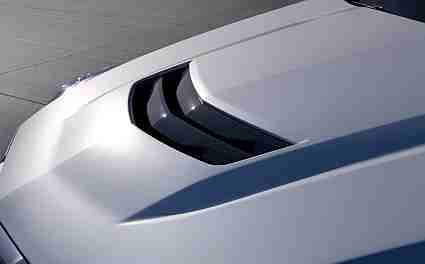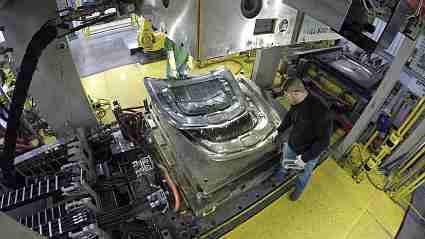Carbon/epoxy Cadillac hood in production
While they typically keep their research efforts close to the vest, automakers and automotive Tier suppliers nevertheless are always in the process of evaluating the multitude of materials available for lightweighting.

Magna International molds this Cadillac hood with carbon/epoxy prepreg from Barrday Composite Solutions.
While they typically keep their research efforts close to the vest, automakers and automotive Tier suppliers nevertheless are always in the process of evaluating the multitude of materials available for lightweighting, in order to meet fuel economy mandates. One example is automotive Tier 1 giant Magna International Inc. (Aurora, Ontario, Canada), a leading automotive supplier with more than 140,000 employees in 29 countries. The company started a carbon fiber composites program in 2008, says Tom Pilette, global vice president, product and process development at Magna: “We began developing composites for structural parts, as well as Class A body panels, and formed a joint development agreement with Zoltek Corp. [Bridgeton, MO, US] using 50K carbon tow material. We saw the lightweighting trend coming, but knew it was going to be a long process.” That early work led to an opportunity in 2013 to submit a quote to General Motors (Detroit, MI, US) for composite hoods for the 2016 model year Cadillac ATS/CTS V-Series cars, two higher-performance Cadillac models. Approximately 7,000 parts are being produced each year for each model, for a total of 14,000 hoods, although capacity exists for much higher volumes. The hood was a winner of a JEC Innovation Award at the just-concluded JEC Americas event in Atlanta, GA, US, in the Automotive category.
Andrew Swikoski, global product line director for lightweight composites, explains that the Cadillac hood was a good candidate part for lightweighting, given its location above the car’s center of gravity and forward of the axle. The carbon composite provides the stiffness needed to avoid hood “flutter” and has resulted in a mass savings of between 20 and 30 percent compared to aluminum or steel hoods (the range is dependent on the grade of steel or aluminum to which it is compared). The out-of-autoclave compression molding process takes just minutes per part, yet produces a Class A surface. A key achievement of the hood program, he adds, is that parts can be post-processed just like metallic versions, that is, the carbon fiber/epoxy material can withstand Magna’s normal part painting process and associated temperatures, without resorting to off-line, manual painting and “finesse and filler” steps. “Our goal was to have a composite part capable of seamless, in-line finish processing,” adds Pilette.
The hood was designed with a unidirectional carbon fiber inner and outer, with an optional exposed carbon fiber inner, adhesively bonded together. Steel hard points are bonded at hinge and latch locations. The outer panel has a thickness of 1.2 mm, and the inner, 0.8 mm. Working closely with material suppliers Zoltek and Barrday Composite Solutions (Millbury, MA, US) at the Magna-NRC Composites Centre of Excellence — a joint Magna/Canadian research center dedicated to composites located at Magna’s Concord, Canada facility — Magna went through “many iterations” of resin chemistry development, prepreg stack design, tool design and cycle time tweaks to achieve an acceptable finished outer surface, says Pilette. The resulting prepreg resin system, supplied by Barrday, is a customized toughened epoxy combined with Zoltek fiber for a prepreg with a high glass transition temperature (Tg) that can handle the Magna paint line temperatures.

This shear-edge steel compression tool, designed by Magna, molds the Cadillac hood in minutes.
“Typically, a prepreg part charge tends to be a patchwork of multiple plies that takes time to lay up manually,” explains Pilette. The Magna team has perfected an automated work cell that creates a molding charge by robotically laying multiple plies of standard-width, 0.02 mm-thick, Barrday prepreg in a 0°/90° orientation, which are CNC cut into a charge pattern that is robotically transferred to the mold. The patented mold design is a shear-edge steel design, with a “unique” and proprietary combination of tooling features that reportedly manage the movement of the stacked plies during mold close and pressure application. Adds Pilette, “The prepreg starts to cure as soon as it hits the heated tool, so the stack has be placed precisely and stay in place. The tool helps maintain resin consistency, ensures good fiber wetout and part thickness.” He notes that Fibersim software from Siemens PLM Software (Plano, TX, US) was a manufacturability tool that “helped tremendously” in developing the prepreg stack pattern for compression molding.
The Barrday material is manufactured in that company’s Cambridge, Ontario, Canada facility, and molding occurs at Polycon Industries (Guelph, Ontario, Canada, a Magna subsidiary). The process begins with automated layup and ply stacking, charge cutting and mold loading. After tool close and press application, cure time takes about 10 minutes. The robot removes the molded part, shuttles it to a router cell for trimming, then to a bonding cell and a fixture. Bonding of the inner and outer panels is also automated, and the metallic hinge and closure elements, while positioned by hand, are also robotically bonded. Pliogrip two-part urethane adhesive from Ashland Performance Materials (Columbus, OH, US) is used. Bonded parts then go to the Magna paint line, and after painting are shipped to General Motors. “We’re now working on cutting that cure time in half, with adjustments to the epoxy,” asserts Pilette.
Pilette and Swikoski both say that, now that a robust and successful molding process has been developed, Magna’s goal is to expand the use of this newly-developed technology with multiple carbon composite body panels, on more platforms. “We understand these materials, and with our in-house chemists and laboratory, and collaboration with our supply partners, we can offer solutions to meet our customers’ needs,” says Pilette. Watch for more composites parts from this automotive powerhouse.
Related Content
Infinite Composites: Type V tanks for space, hydrogen, automotive and more
After a decade of proving its linerless, weight-saving composite tanks with NASA and more than 30 aerospace companies, this CryoSphere pioneer is scaling for growth in commercial space and sustainable transportation on Earth.
Read MoreCarbon fiber, bionic design achieve peak performance in race-ready production vehicle
Porsche worked with Action Composites to design and manufacture an innovative carbon fiber safety cage option to lightweight one of its series race vehicles, built in a one-shot compression molding process.
Read MoreBladder-assisted compression molding derivative produces complex, autoclave-quality automotive parts
HP Composites’ AirPower technology enables high-rate CFRP roof production with 50% energy savings for the Maserati MC20.
Read MoreMcLaren develops aerospace-inspired ART method for volume composite super car engineering
Automated rapid tape (ART) technique, already deployed at the MCTC and to be used for future McLaren models, is capable of producing lighter, stiffer and stronger carbon fiber structures with less waste.
Read MoreRead Next
Cutting 100 pounds, certification time for the X-59 nose cone
Swift Engineering used HyperX software to remove 100 pounds from 38-foot graphite/epoxy cored nose cone for X-59 supersonic aircraft.
Read MoreNext-gen fan blades: Hybrid twin RTM, printed sensors, laser shock disassembly
MORPHO project demonstrates blade with 20% faster RTM cure cycle, uses AI-based monitoring for improved maintenance/life cycle management and proves laser shock disassembly for recycling.
Read MoreUltrasonic welding for in-space manufacturing of CFRTP
Agile Ultrasonics and NASA trial robotic-compatible carbon fiber-reinforced thermoplastic ultrasonic welding technology for space structures.
Read More












